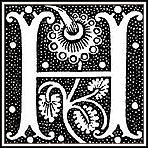


 |
 |
Lancashire North of the Sands: Directory of Baronies and Superior Manors
Furness, Liberty of, or Furness Lordship
In 1066, most of the Furness area was held by Earl Tostig, as part of his fee of ‘Hougon’. In 1127, Stephen Count of Boulogne (who then held the honour of Lancaster) gave parts of Furness for the founding of Furness Abbey, and over the following centuries further lands, dues and services in the area were granted or confirmed to the abbots of Furness. One important area excluded from Stephen’s original grant were the lands held by Michael le Fleming of Aldingham, which later came to be known as the manor of Michael-land or Muchland. Around 1160 immediate lordship of the upland region of Furness was divided between Furness Abbey and William de Lancaster, with the Abbey holding the eastern fells around Hawkshead and Colton (known as Furness Fells), and William de Lancaster holding the western fells around Coniston and the lands of Ulverston. Eventually, however, a portion of the Lancaster’s Ulverston estate also fell to the Abbey.
Though it can be stated that all manors in the Furness peninsula and Furness Fells lay within the lordship of Furness, and that the abbots of Furness were superior lords over the whole district, in practice the abbots had immediate control over only certain areas, centred on the parishes of Dalton, Hawkshead and Colton, and a portion of Ulverston. As a result, the records of the lordship courts deal largely with those manors and parcels of land over which the monks had immediate control, rather than the whole of Furness. From 1537, the lordship of Furness was held by the Crown, and was granted to the Duke of Albermarle in around 1666. It seems that the notion of a ‘Liberty of Furness’, with ‘Liberty’ courts, gathered momentum in the eighteenth century. The Liberty of Furness and a number of member manors eventually descended to the Dukes of Buccleuch, and to the Dukes of Dalkeith, who continued to hold courts for the Liberty and its associated manors into the early twentieth century.
For purposes of administration and jurisdiction, Furness lordship was spilt into two main parts: Low Furness and the Furness Fells. The lowland areas of the lordship (including the manors of Dalton, Plain Furness, Egton with Newland) were administered from Dalton. The upland regions – the Furness Fells – were administrated from Hawkshead, where the abbots’ court house still stands (see picture below).
Furness Fells
Furness Fells was a name for the upland area of the Furness Abbey estates which lay between the lakes of Coniston and Windermere, and ranged from Haverthwaite in the south up to the River Brathay in the north. Furness Fells largely consisted of the large manor of Hawkshead, with its several bailiwicks. Overall administration was based at the abbot’s house at Hawkshead, but for certain purposes the manor of Hawkshead or Furness Fells was divided into two areas: Furness Fells north of (or over) Ravenstye, and Furness Fells south of (or under) ‘Ravenstye’ (the name ‘Ravenstye’ appears to now be lost). Courts for the south of ‘Ravenstye’ might sometimes be held at Colton. The several bailiwicks or estates within the manor of Hawskhead included Arnside, Colton, Satterthwaite, Graythwaite, Haverthwaite etc. and these sometimes appear as ‘manors’ in the records though they did not actually have such status. All records for the Furness Fells area are registered under the manor of Hawkshead on the MDR but, where possible, the document descriptions identify the division or bailiwick to which it relates – e.g. ‘court roll, Colton’.
Hawkshead Courthouse, from the inner courtyard
Credits: This site is maintained by Dr Angus Winchester and Dr Eleanor Straughton. For advice about access issues, please visit the Department's Accessibility Advice Page.
Copyright: Department of History, Lancaster University | Disclaimer: as per university policy.